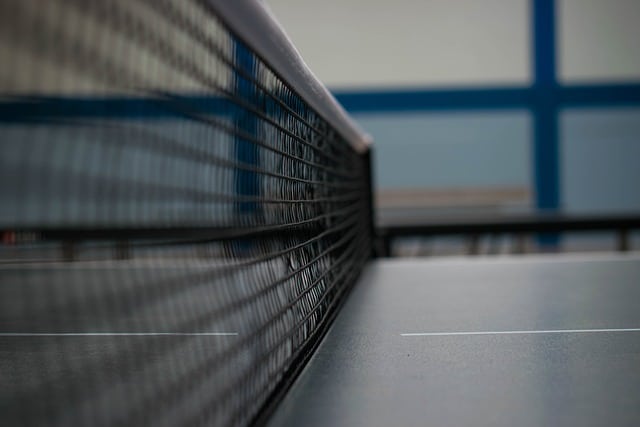Ping pong tables are large and take up a large amount space in your basement. It’s important to ensure you have the enough room given the fast-paced action that ping pong requires.
But ping pong table size isn’t the only thing to consider before you purchase one. Far from it.
Here are 10 tips to consider before you purchase a ping pong table along with a short list of options to look at.
- Measure your space: Before purchasing a ping pong table, measure your basement to make sure that you have enough room for it. A full-size table is 9 feet long, 5 feet wide, and 2.5 feet high, so make sure you have enough space for the table and for players to move around it.
Click here for an entire article on ping pong table sizing and specs. - Check the thickness of the playing surface: The thickness of the playing surface is an important factor in determining the quality of a ping pong table. A thicker surface will provide a better bounce and a more consistent playing experience. A good quality ping pong table typically has a playing surface that is at least 0.75 inches (19mm) thick. This thickness provides a consistent bounce and allows for a more professional playing experience.
However, some high-end ping pong tables may have playing surfaces that are up to 1 inch (25mm) thick or even thicker, which can provide an even more consistent bounce and improve the overall quality of play. - Consider the quality of the frame and legs: The frame and legs of a ping pong table should be sturdy and durable to support the weight of the table and withstand regular use.
Look for tables with frames made of steel or other high-quality materials. - Look for a table with adjustable legs: Adjustable legs are important for leveling the table on uneven surfaces. Look for tables with adjustable legs to ensure that you have a level playing surface.
- Choose the right playing surface color: The color of the playing surface can affect the visibility of the ball. While green is the traditional color, some players prefer blue or gray surfaces, which can be easier on the eyes. Blue tables in particular have become popular in recent years and are often used in high-level tournaments.
You can also choose different color ping pong balls. - Consider the type of wheels: Ping pong tables with wheels make it easier to move the table around your basement. Look for tables with large, sturdy wheels that can withstand the weight of the table.
Ping pong table wheels are typically made from hard plastic or rubber, and are designed to be durable and long-lasting. These materials allow the wheels to roll easily over a variety of surfaces, including carpet, tile, and hardwood.
In terms of locking mechanisms, many ping pong table wheels are designed to lock in place to prevent the table from moving during play. This is especially important for tables that are designed to be portable or have foldable legs, as these tables are more prone to moving during intense gameplay. - Look for foldable options: If you have limited space in your basement, consider purchasing a ping pong table that can be folded up for storage when not in use.
Foldable ping pong tables are more convenient due to their space-saving ability but they are also easy to set up and relocate. Plus they are more versatile as you can set the table up to practice alone if you don’t have a second player to play against. - Consider the quality of the net and post set: The net and post set is an important part of the playing experience. Look for tables that come with high-quality net and post sets that are easy to install and adjust.
Ping pong nets and posts are typically made from a combination of plastic, metal, and sometimes other materials such as rubber. The net itself is usually made from a synthetic mesh material, such as nylon or polyester, which is strong and durable enough to withstand the impact of the ping pong ball.
The posts, on the other hand, are typically made from metal or plastic and are designed to hold the net in place securely. The posts may be adjustable, allowing you to raise or lower the net as needed to meet specific regulations or accommodate different players. - Look for additional features: Some ping pong tables come with additional features, such as built-in ball holders or scorekeepers. Consider these options if you want to add some extra functionality to your table.
- Read reviews and do your research: Before purchasing a ping pong table, read reviews from other customers to get a sense of the quality and durability of the table.
Major quality brands of ping pong tables include JOOLA (Germany), Butterfly (Japan), Stiga (Sweden), Killerspin (US), and Cornilleau (France).
Also, make sure to do your research to find a table that fits your specific needs and preferences.
Cool options to consider for your ping pong table
- Built-in LED lights: Some ping pong tables come with built-in LED lights that can add a cool, futuristic look to your basement.
- Conversion tops: If you want to use your ping pong table for other activities, consider purchasing a conversion top that can turn your ping pong table into a pool table or other game table.
- Weather-resistant tables: If you want to use your ping pong table outdoors, consider purchasing a weather-resistant table that can withstand the elements.
- Custom designs: Some ping pong table manufacturers offer custom designs, so you can create a table that perfectly fits your style and preferences.
- Playback mode: Some ping pong tables come with a playback mode that allows you to practice your skills by hitting the ball against a folded-up side of the table.


